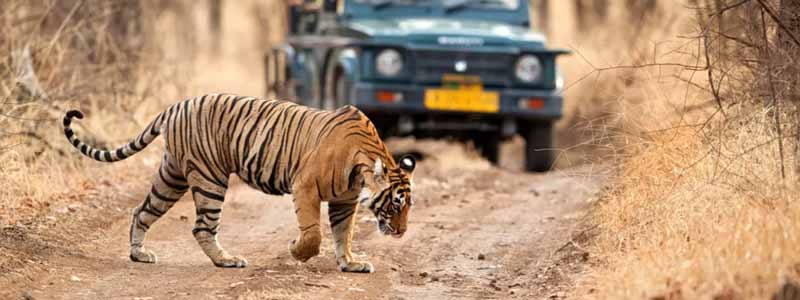How to Plan Ranthambore National Park, nestled in the rugged terrain of Rajasthan, India, is a sanctuary of untamed beauty and thriving wildlife. Spanning over 1,300 square kilometers, it stands as a testament to nature’s resilience.
Central to Ranthambore’s allure is its population of majestic Bengal tigers. These apex predators, with their distinctive orange coats and dark stripes, reign over a diverse landscape of dry deciduous forests, lakes, and ancient ruins. The thrill of encountering one of these magnificent creatures in their natural habitat is an experience that leaves an indelible mark on visitors How to Plan Ranthambore.
The park’s historical tapestry is woven with the remnants of a bygone era, including the formidable Ranthambore Fort. This ancient fortress, perched atop a hill, bears witness to centuries of history and offers panoramic views of the park below.
Ranthambore is a birdwatcher’s paradise, with over 300 avian species gracing the skies and water bodies. Elegant waterfowl, vibrant kingfishers, and majestic birds of prey create a vibrant avian symphony.
As day transitions into night, the call of nocturnal creatures adds a layer of intrigue to the park’s mystique. Leopards, sloth bears, and elusive jungle cats emerge from the shadows, offering a rare glimpse into their secretive lives How to Plan Ranthambore.
Ranthambore National Park is not merely a sanctuary; it is a living testament to the harmonious coexistence of wildlife and history, where nature’s splendor and ancient legacies converge in breathtaking harmony. For those who venture within its bounds, it is an immersion into the raw beauty and untamed spirit of the natural world.

What is the Best time to travel to Ranthambore?
The best time to travel to Ranthambore is the winter season, between October and March because of its pleasant weather. The best time to see a tiger in Ranthambore is from April to June, but it’s really hot in these months.
The Park remains open between October and June and closed during the rainy season.
Most of the music festivals are in the month of December.
Tip: December is the best month to visit, and also the most crowded month of the year. So definitely pre-book everything. Ranthambore temperature in December is – max 25 degrees and reaches down till 10 degrees.
Important Note:
The Jeep safari and Canter Safari are the only two commuting options to explore the How to Plan Ranthambore National park.
- Carry some light and comfortable clothing that is suitable for forest visit.
- Carry your camera for sure.
- Never take along Weapons and sharp objects.
- Never indulge in criminal offences.
- Do not try to disrespect plantations, animals and birds.
- Keep your phone in silent mode.
- Carry light luggage and take care of your belongings as well.
- When doing safaris do not go very close to the tiger and other wild animals.
Zones of Ranthambore National Park
Jungle Safari at Ranthambore National Park is one of the best places for Wilderness vacation in India. Zones 1–5 are called the park’s “core” and are the most popular safari destinations because they provide the best chances of encountering tigers. Zones 6–10 are known as “border zones,” because they are less popular, however, tigers can still be found there. During the monsoon season, most of the park, including core zones 1–5, is closed from July through September Ranthambore Tour Packages.
Zone 1 – Zone 1 starts from The Singh Dwar. It is one of the best zones for Tiger sightings. You can easily spot tigers at Amreshwar Dang, Tuti ka Nalla, Sultanpur, Gada Dub, and Peela Pani.
Zone 2- This is the only zone with water holes which is the reason why it has a high chance for tiger sightings. You can spot tigers and leopards at Phuta Bandha, Jogi Mahal, Phuta Kot, Lahpur Tiraha, and Nal Ghati.
Zone 3- Raj Bagh, Padam Talab, Mandook, Jogi Mahal, and High Point are some of the best spots to spot tigers in this zone. It is one of the most popular Tiger sighting zones at Ranthambore.
Zone 4- The famous tigress Machli used to live in this zone but now she is dead. Some of the most famous tigers spotted here are T-28, T-64,T-19,T-41 etc. You can spot Tigers at Adidaant, Singh Dwar, Tamakhan, Lakkad Da, Lambi, Malik Talab, and Berda How to Plan Ranthambore.
Zone 5– Jokha, Singh Dwar, Dhakda, Baghda, Anatpur, Bakola, and Kachida are some of the best spots for tiger sightings here.
Zone 6-This is one of the most beautiful zones of Ranthambore. You will witness beautiful grasslands, mountains and dense forests which is a perfect haunt for nature photographers. Its boundary is shared with Zone 1 so you will also be able to spot Tigress Noor with her cubs.
Zone 7- You can spot T-34 and T-8 here. Some Of the most famous spots for Tiger sightings are Chidikho,Jamoda,Rajbagh Naka and Kushalipura.
Zone 8- Balas, Kherai,Kali,Neemli Dang, Bhat,Mahakho are the major areas where you can spot wild creatures. It is one of the most popular buffer zones of Ranthambore park. You will spot leopards and amazing birds like Honey Buzzard, Indian Courser etc.
Zone 9- Serene banks of Chakal river adds to the beauty of this zone. This place is very popular for Caracal, sloth bear and aquatic birds. It is also home to tigress T-59, T-62.
Zone 10- This zone is a birdwatcher’s paradise and also famous for Tiger, Leopard, Sloth bear, Antelope, Jackal sightings. This zone is a home to a male tiger T-42 aka Fateh, T-13 and her cubs.
How to Reach Ranthambore
Ranthambore, the popular wildlife attraction in Rajasthan, is well connected with all the major cities in India. However, the easiest way to reach Ranthambore National Park is to take a train to Sawai Madhopur Railway Station, which is connected to cities like Jaipur, Mumbai, and Delhi. If tourists are travelling by air, then Jaipur is the nearest airport, which is well connected to the major cities of India.
Many popular airlines operate daily flights to Jaipur from other many cities of India. International tourists can either board their flights at Jaipur International Airport or Delhi Airport, and then take a cab or train to reach Ranthambore National Park. Here’s information about the nearest airport & railway station to Ranthambore and national highways which connect Ranthambore to other cities.
By Air: The nearest airport to reach Ranthambore National Park is Sanganer Airport in Jaipur. The distance between Jaipur and Ranthambore is about 180 km and there are regular flights for Jaipur from all the major cities including, Delhi, Mumbai, Chennai, Bangalore, etc. The tourists can take a direct taxi or bus from Sanganer Airport to reach Ranthambore safely.
By Rail: The nearest railway station that connects Ranthambore National Park to other important cities is Sawai Madhopur Railway Station, which is located at a distance of 10 km from the park. The tourists can avail local bus, taxi, or cab to reach the Ranthambore park smoothly How to Plan Ranthambore.
By Road: Ranthambore is well connected with all the major cities and towns through state bus service and it can be reached through private buses and taxis. Jaipur, Delhi, Ahmedabad, Ajmer, and Jodhpur can be easily travelled from Ranthambore.
- Delhi to Ranthambore: 381 Km (Approx. 6 Hours via NH8 and NH 11A)
- Jaipur to Ranthambore: 180 Km (Approx. 3h via Rajasthan State Hwy 24)
- Udaipur to Ranthambore: 388 Km (Approx. 6h 10 min via NH 76 and RJ SH 29)
- Agra to Ranthambore: 239 Km (Approx. 4h 23 min via via RJ SH 1)
- Bharatpur to Ranthambore: 202 Km (Approx. 3h 37 min via RJ SH 1)
- Ahmedabad to Ranthambore: 640 Km (Approx. 9h 47 min via NH8 and NH 76)
- Mumbai to Ranthambore: 1031 Km (Approx. 16 h 51 min via NH 3)
